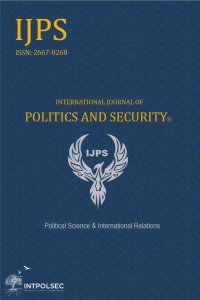Importance of the Arctic in the Framework of Air Power Theory
Hava Hakimiyeti Teorisi, Jeopolitik Toeriler, Arktik, Kuzey Kutup Dairesi, Alexander P. de Seversky
Importance of the Arctic in the Framework of Air Power Theory
___
- Castagna, JoAnne. “Things are looking up at Arctic Air Base.” U.S. Air Force, January 17, 2018. https://www.af.mil/News/Article-Display/Article/1417030/things-are-looking-up-at-arctic-air-base/.
- Chapman, Bert. Geopolitics: A Guide to the Issues. California: Praeger, 2011.
- Connolly, Gerald E.. “NATO and Security in the Arctic.” NATO, October 7, 2017. https://www.nato-pa.int/download-file?filename=%2Fsites%2Fdefault%2Ffiles%2F2017-11%2F2017%20-%20172%20PCTR%2017%20E%20rev.1%20fin%20-%20NATO%20AND%20SECURITY%20IN%20THE%20ARCTIC.pdf.
- Dadwal, Shebonti Ray. “Arctic: The Next Great Game in Energy Geopolitics?.” Strategic Analysis 38, no. 6 (2014): 812-824.
- Davutoğlu, Ahmet. Stratejik Derinlik. 95th. edition, İstanbul: Küre Yayınları, 2014.
- Douhet, Giulio. The Command of The Air. Washington, D.C.: Air Force History and Museums Program, 1998.
- Erokan, İslam. “Merkator Projeksiyonu.” Harita Dergisi 26, no. 61 (1960): 5-15. https://www.harita.gov.tr/images/dergi/makaleler/70fcb77e6349f44.pdf.
- Goldstein, Joshua S., and Pevehouse, Jon C.. Uluslararası İlişkiler. 2nd. edition, Ankara: BB101 Yayınları, 2017.
- Kaplan, Robert D.. The Revenge of Geography. New York: Random House Trade Paperbacks, 2013.
- Lambeth, Benjamin S.. “Air Power, Space Power and Geography.” Journal of Strategic Studies 22, no. 2-3, (1999): 63-82.
- Lopez, C. Todd. “Air Force Reveals Cold Facts on New Arctic Strategy.” U.S. Dept. Of Defence, July 21, 2020. https://www.defense.gov/Explore/News/Article/Article/2281961/air-force-reveals-cold-facts-on-new-arctic-strategy/.
- Meilinger, Phillip S.. “Proselytiser and Prophet: Alexander P. de Seversky and American Airpower.” Journal of Strategic Studies 18, no. 1 (1995): 7-35.
- O’Rourke, Ronald et al.. “Changes in the Arctic: Background and Issues for Congress.” Congressional Research Service, 2020.
- Özey, Ramazan, and Kocalar, Ali Osman, Siyasi Coğrafya. 19th. edition, İstanbul: Aktif Yayıncılık, 2019.
- Renner, George T.. Human Geography in the Air Age. New York: The Macmillan Company, 1942.
- Seversky, Alexander P. de. Air Power: Key to Survival. New York: Simon and Schuster, 1950.
- Sørensen, Camilla T. N.. “Changing Geopolitical Realities in The Arctic Region: Possibilities and Challenges for Relations Between Denmark and China.” Newsletter for Center for Polar and Oceanic Studies 3, no. 2 (2014): 2-7. https://pure.fak.dk/files/7289274/Tongji_article._Arctic_region..pdf.
- Strandsbjerg, Jeppe. “Cartography and Geopolitics in the Arctic Region.” DIIS Working Paper, no. 20, 2010.
- Şener, Bülent. Jeopolitik: Uluslararası İlişkilerde İnsan, Devlet, Coğrafya ve Zaman Etkileşimi Üzerine Bir Giriş. Ankara: Barış Kitabevi, 2017.
- Tamnes, Rolf, and Offerdal, Kristine. “Introduction.” in Geopolitics and Security in the Arctic, edited by Rolf Tamnes and Kristine Offerdal, 1-12. New York: Routledge, 2014.
- Tremoglie, Christopher. “Arctic Geopolitics Reconsidered: Pathways to Conflict and Cooperation.” CUREJ: College Undergraduate Research Electronic Journal, University of Pennsylvania, (June 2020). https://repository.upenn.edu/curej/250.
- Warden, John A.. “Strategy and Airpower.” Air & Space Power Journal 25, no. 1 (2011): 64-77.
- ISSN: 2667-8268
- Yayın Aralığı: Yılda 2 Sayı
- Başlangıç: 2019
- Yayıncı: Fikret BİRDİŞLİ
Arktik Konseyi ve Türkiye’nin Unutulan Arktik Konseyi Gözlemci Üyelik Başvurusu: İsviçre Örneği
Arktik Bölgede Çevresel Bozulma, Strateji ve Rekabet: Çevresel Güvenlik Bağlamında Bir Değerlendirme
İsmail Utku CANTÜRK, Senem ATVUR
Russia's Arctic Policy: Economic Development, Regional Priorities, Territorial Sea
Elif Hatun ÖNAL - KILIÇBEYLİ, Inga SOCHNEVA, Oleg SOCHNEVA
Arktik Yerli Halkları için İnsan Güvenliği Sorunu Olarak İklim Değişikliği
Arktik Bölgesinde Yaşanan Güncel Sorunlar ve İkili Anlaşmazlıklar
Ozone Diplomacy, Ozone Regime Negotiations and Arctic
Kuşak ve Yol Girişimi Bağlamında Çin’in Arktik Politikası
Importance of the Arctic in the Framework of Air Power Theory
Tarihten Bugüne Rusya'nın Arktik Politikaları: Değişimler ve Süreklilikler
Oya DAĞLAR MACAR, Bumin Kağan OĞUZ
Climate Change and Hard-Soft Security Nexus: Future of Arctic Security Cooperation
